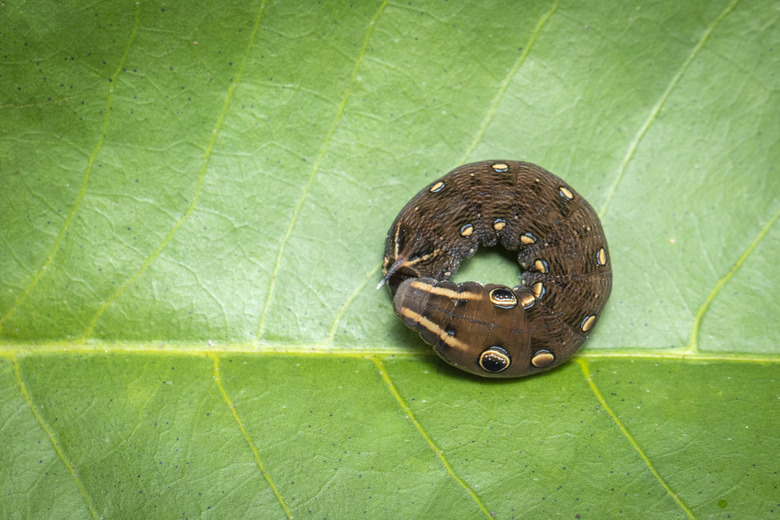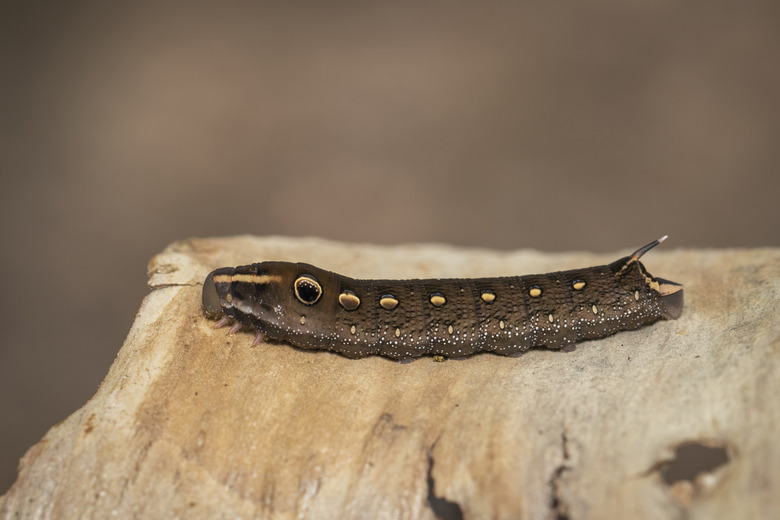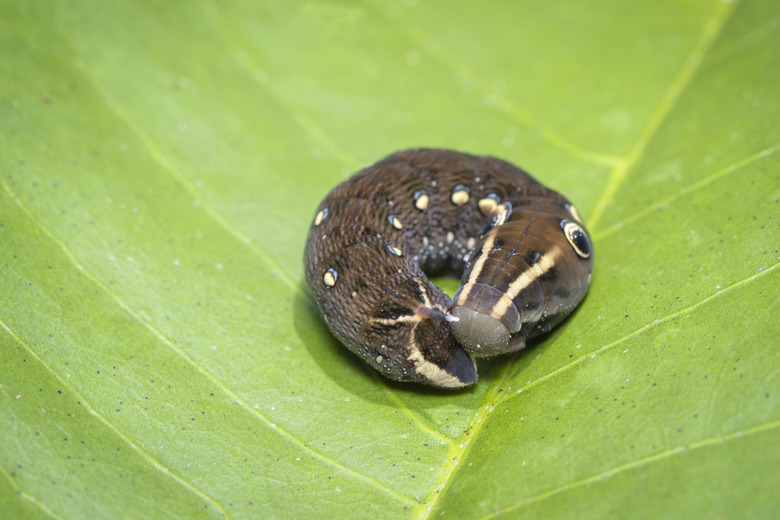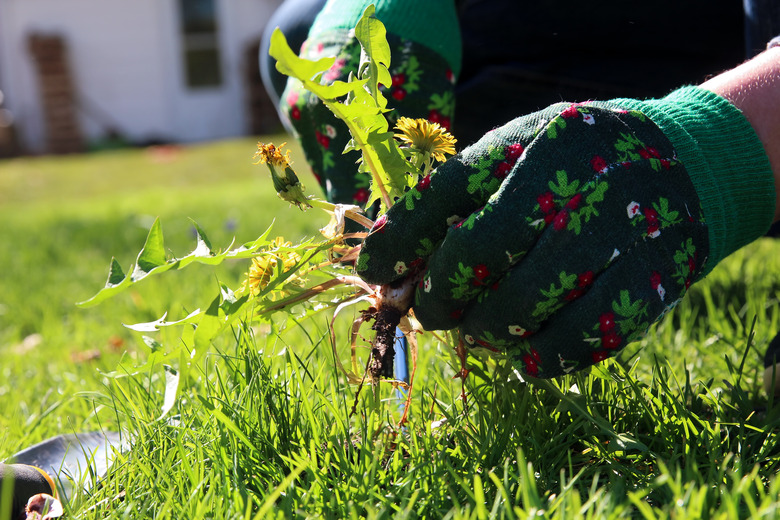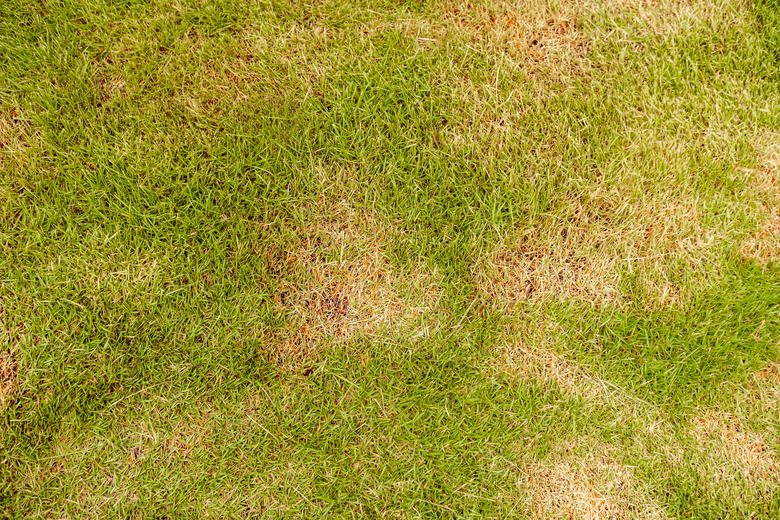How To Get Rid Of Armyworms
We may receive a commission on purchases made from links.
Many homeowners pride themselves on their lawn care expertise and their lush, healthy lawn, but when irregularly shaped brown patches appear on turf seemingly out of nowhere, it's time to start monitoring the area for armyworms. Armyworms feed like an invading force as large numbers of caterpillars swarm across a lawn, leaving a path of destruction behind them.
While each individual caterpillar may be small, each female moth lays thousands of eggs in its short life span, and the sheer number of these pests means they can quickly cause quite a bit of damage. In fact, in large enough numbers, these creatures can wipe out an entire football field in less than three days. While most infestations need to be handled with pesticides, it is typically best to use natural insecticides to target these pests without harming beneficial insects that can help you fight these infestations.
What Do Armyworms Look Like?
What Do
Armyworms Look Like?
- Species name: Spodoptera frugiperda
- Physical characteristics: Armyworm caterpillars grow up to 1 1/2 to 2 inches long and come in green, brown, or black with green, yellow,
brown, or red stripes along their body. The cocoon used in the pupal stage can
be found under the soil and is 1/2 inch long with a reddish-brown color.
Adult moths come in a variety of shades of brown and white and in differing sizes
depending on the species. - Wings or wingless? Armyworm
larvae and pupae are wingless, but the adult moths have wings.
- Color/species varieties: While all species of armyworms
cause damage to yards and crops, fall armyworms pose the greatest threat to
the majority of home landscapes in America. As adult moths, they are small with gray,
mottled front wings and white hind wings. As caterpillars, fall armyworms come
in a variety of colors, but they can usually be identified by the inverted "Y"
on the front of their head. In some areas, such as Utah, the true armyworm is the more destructive pest. As a caterpillar, it has a similar appearance to the fall armyworm only it does not have the distinctive "Y" marking on its head. As an adult, it has tan wings with light mottling on the front wings. - Life cycle and appearance: Female armyworm moths lay eggs
along the base of host plants or on host tree leaves, which hatch within a few
days. The caterpillars eat for 14 to 21 days before entering the pupa stage, at
which point they will burrow into the soil. After 10 to 14 days, the pupa will
mature into an adult armyworm moth and emerge from the soil. Adult moths live
an average of 10 days. - Armyworms vs. cutworms: Armyworms and cutworms are both destructive caterpillar species that can destroy crops and
landscaping. Because both types of caterpillars have multiple species and a
variety of color combinations, it can be difficult to distinguish between the
two, but typically, cutworms are solitary eaters, while armyworms feed as one
huge group. The good news is that the pest control methods for both of these
destructive insects are the same.
How to Get Rid of Armyworms
How to Get
Rid of Armyworms
The best form of armyworm control for your situation will vary based on the severity of the infestation. If you identify an armyworm problem early enough, you may not need to resort to pesticides at all, and you may be able to remove the pests by hand. In most cases, though, pesticides are necessary. Alternatively, you may turn to natural predators, such as birds, frogs, turtles, and nematodes. Whatever control method you use, it's best to target the pests in the early morning or late evening since these are the armyworm's most active feeding times, and your efforts will be most effective since they will be out in the open.
Remove Worms by Hand
For a small infestation caught early, you may be able to remove the armyworms by hand, dropping them into a bucket of soapy water to help ensure they die and don't just live in your garbage can. This method tends to be easier in gardens and landscape plants than on turf, where the larvae tend to hide in the thatch most of the day, but you can still remove the caterpillars during their active feeding times even on your lawn.
Once you have removed the caterpillars, you need to take action to kill the unhatched eggs. You can manually remove and destroy all plants on which you found armyworms if you prefer to use no chemicals in your garden; you can introduce natural predators, such as nematodes or wasps; or you can spray the plants with an insecticide that kills eggs. Be sure to clean all of your garden tools after removing the larvae to remove any eggs that may have attached to them.
Natural Pesticides
While there are many generalized synthetic insecticides available that can kill off armyworms, it's typically best to use a natural pesticide that does not kill so indiscriminately so you do not harm beneficial insects. A few recommended products include:
-
Neem oil: Made from neem leaves, this product can kill armyworms at all stages of their
life cycle. This pesticide needs to be applied on all sides of a plant,
including the underside of the leaves. It's worth mentioning that some plants can be harmed by neem oil, so always do your research before applying it to a plant and always use this product according to the manufacturer's directions. -
Pyrethrin:
A natural pesticide made from dried chrysanthemums, it paralyzes armyworms and other
caterpillars on contact but has no residual effects. -
Spinosad:
This pesticide is made of a soil bacterium that kills problematic pests on contact or after
ingestion by affecting the target's nervous system, eventually causing
paralysis and death. -
Bacillus thuringiensis: This liquid pesticide is made from a bacterium that paralyzes the
digestive system of armyworms and other caterpillars. -
Diatomaceous earth: Made from fossilized aquatic organisms, these sharp particles cut
open the exoskeleton of armyworm larvae, leaving them to dehydrate from the
inside out.
Because armyworms hide in the deep thatch layer of grass, you may need to aerate your lawn before applying pesticides if the thatch layer is thicker than 1/2 inch. Mowing your lawn down to 1 1/2 inch can also help pesticides penetrate to where the armyworms like to hide.
Use Natural Predators
There are many creatures out there that naturally target armyworms. In fact, 60 to 90 percent of armyworm caterpillars are eaten by predators before they reach adulthood. You can help increase this percentage by encouraging song birds in your garden by installing birdhouses and birdbaths. In fact, birds love to eat armyworms so much that sometimes, the first sign of an infestation is a flock of birds foraging in the yard. Frogs and turtles also like to eat armyworms, so you can try to set out pools of water along the ground to attract these useful predators to your yard.
You can even bring in your own army to fight an armyworm infestation by purchasing beneficial nematodes, specifically Steinernema carpocapsae, which eat both armyworm eggs and pupae. Apply these in the morning or evening to help the nematodes avoid high heat and direct sunlight. Water your lawn before and after application to make it easier for the nematodes to move through the thatch of your grass. You may need to apply nematodes multiple times to eliminate your armyworm infestation.
You can also purchase and release trichogramma wasps, lacewings, or minute pirate bugs into your yard since all of these insects eat or otherwise destroy armyworm eggs.
Tip
Be sure to consult with your local cooperative extension before purchasing predator insects to ensure that you won't inadvertently cause another infestation.
Where Armyworms Come From
Where
Armyworms Come From
Armyworms are most active from mid-March to October, but they die out on their own in most climates during the winter. In south Texas and Florida, armyworms can overwinter and be active all year. Because armyworms work their way north from the southernmost part of the United States, they typically don't reach areas like Minnesota or New York until August, and they may only live for one generation in these cooler climates before dying off. In some warmer years, moths may start making their way north earlier than usual and live an additional one or two generations as a result.
Female armyworms lay as many as 50 eggs at a time, typically on host plants, though they may even lay eggs on telephone poles, buildings, fences, and more, and the larvae will then simply find their way to the nearest food source upon hatching. During the 10 or so days of an adult armyworm's life, it will not eat but will spend its days mating. Females can lay up to 2,000 eggs in their lifetime, which is why the swarms of caterpillars are so massive and destructive.
The life span of armyworms varies based on the climate, with those that hatch in summer reaching maturity within 30 days, those that hatch in spring and fall living 60 days, and those that live through the winter surviving up to 90 days.
How to Prevent Armyworms
How to Prevent Armyworms
Keeping your lawn healthy is the best way to prevent an armyworm infestation, and it's the best way to ensure your grass will bounce back if it is infested. Female moths tend to lay eggs on overly wet lawns and lawns with thick layers of thatch. Dethatch your lawn as needed, do not overwater your lawn, and try to keep weed grasses to a minimum. While keeping your lawn healthy is important, overfertilizing can result in lots of new growth areas where female armyworms are more inclined to lay their eggs, so try to stick with a regular fertilization schedule of twice a year.
You can also make your lawn more resistant to armyworms by overseeding it with grass seeds for varieties that contain "endophytic" fungi. This will discourage armyworms and other pests from feeding on your grass.
No matter the condition of your lawn, be sure to regularly check it for armyworm caterpillars or moths so you can start treatment as soon as possible if you discover them. As long as it is healthy when infested, Bermudagrass will typically grow back, but fescue and ryegrass often get stunted or completely killed off by armyworm infestations, so it is particularly important to monitor lawns made up of these more susceptible grass types.
Signs of Armyworm Damage
Signs of Armyworm Damage
One of the first signs of armyworm damage that most people will notice are patches of browned grass. In many cases, people believe their grass is suffering from drought damage, but if left alone, the brown patches will quickly get bigger.
If you inspect infested grass before the armyworms start killing off whole patches, you might notice that the edges of grass blades look ragged or chewed. The blades may even look translucent since young caterpillars can't eat all the way through the grass. As a matter of fact, 93 percent of all damage done by these insects occurs when they are in their fourth and fifth larval stages, and before then, they do minimal damage. This is why if you see even one armyworm larva or moth in your yard, it's time to take action before any serious damage is done.
Armyworms frequent over 80 varieties of host plants, but some of their favorites are grasses. They particularly like Bermudagrass, ryegrass, Sudan grass, fescue, and weed grasses, like crabgrass. Fruit and vegetable plants may also be targeted, including corn, apple trees, grapes, papaya trees, peach trees, and strawberries.
References
- Utah State University Extension: Armyworms and Cutworms in Turfgrass
- University of California Statewide Integrated Pest Management Program: Cutworms and Armyworms
- University of Florida: Fall Armyworm
- Texas A&M University: Armyworm
- Home Depot: How to Get Rid of Armyworms
- Planet Natural Research Center: Armyworm
- Plant Care Today: Naturally Get Rid Of Army Worms Garden Pests
- Yardener: Preventing Armyworm Next Year
